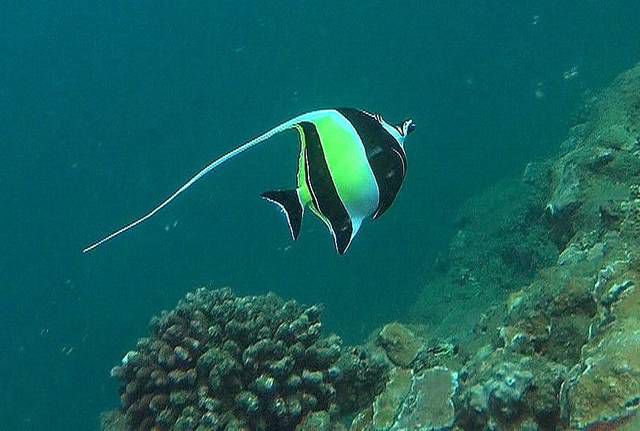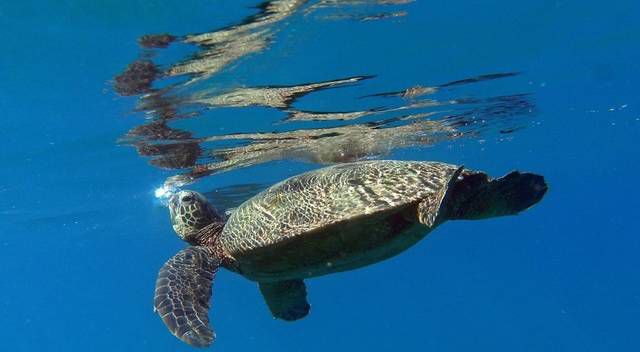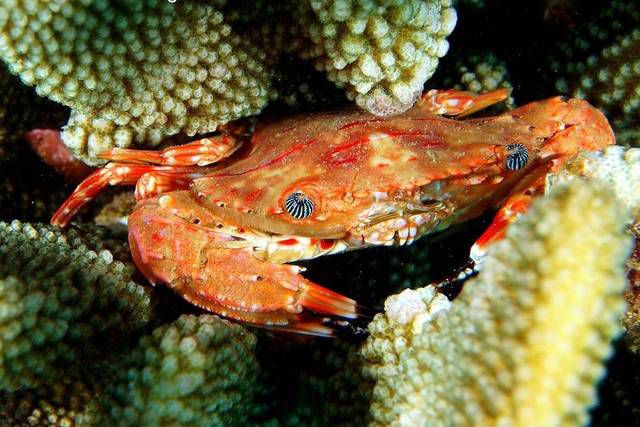This is the eighth in a series on the health of coral reefs globally and around Kauai. It will wrap up with a final story Monday. ANINI — In about 4 feet of water on a sunny morning in Anini
This is the eighth in a series on the health of coral reefs globally and around Kauai. It will wrap up with a final story Monday.
ANINI — In about 4 feet of water on a sunny morning in Anini Bay, Hawaii’s state fish, the humuhumunukunukuapua’a, or a reef triggerfish, zigzagged through a tunnel in the reef.
It leads a solitary life, nibbling on the coral and creating sand in its wake, but it’s not the only thing that lives within the underwater infrastructure that corals create.
“The reef is home to countless creatures,” said Robin Mazor of ReefGuardians Hawaii. “And all of it is dependent upon the coral. It all starts there.”
A little way off from the triggerfish’s domain, a large branching cauliflower coral stretched from the seafloor, providing shelter for a cluster of ‘alo’ilo’i, or Hawaiian dascyllus.
Turtles cruised through the shallow bay, munching on vegetation growing in the sand and around the coral, or hanging out for a quick cleaning session from a variety of fish species that eat algae.
And that’s just one of many places around Kauai where people can see vibrant underwater life. Turtles, fish and even an occasional shark can be seen at places like Poipu, Makua and Koloa Landing.
But those who don’t spend time underwater might be unaware of the teeming life below the waves, or the threats it faces. ReefGuardians Hawaii wants to change that.
Education and direct exposure are the two tools the organization plans to use. Some of those tools are already in place, like Eyes of the Reef — which allows anyone who is interested to help gather data about the health of the reefs around Hawaii.
Some strategies are in the works, like educational snorkeling sessions for kids this summer on Kauai, for which ReefGuardians is gathering volunteers.
“I think the ultimate goal is to get more people involved in actively caring about the reef and collecting information about our reefs through programs such as Eyes of the Reef,” said Katie Nalesere, education and outreach coordinator for the state’s Department of Land and Natural Resources’ Division of Aquatic Resources.
While those with constant access to the water can learn about the environment firsthand, and can actively help with efforts to save the coral reefs, many who come to Hawaii are visiting the islands for a short time.
That’s where video footage from Hanalei marine biologist Terry Lilley comes into the picture.
He’s working with Tom Woods, who is also part of ReefGuardians Hawaii, to put together a membership-based website where folks can see footage of Hawaii’s underwater life before they arrive.
“This is a site where people can learn about the sea life from a Hawaiian cultural viewpoint, and see the connection of it all,” Woods said. “We’ll share clips from the thousands of hours of video and give people the experience before they get here.”
The underwater footage also will be used as a teaching tool, showing proper behavior while on the reef — like not stepping directly on the corals and allowing the animals space when you’re in their vicinity.
Education is key
Education is the key to preserving the reefs, said Eric Brown, a marine ecologist with the National Parks Service, because even the best management practices really only address the results of the problem.
Undertaking the best management practices when it comes to upslope development, establishing marine managed areas, treating sewage adequately, reducing carbon emissions, enforcing conservation laws, are all “excellent steps to protect coral reef ecosystems,” he said.
But, Brown said, people will not change their poor behavior patterns unless they begin to understand how their actions impact how reef ecosystems function, and how important these reefs are to their own health and survival.
“Ultimately, compliance is better than enforcement,” he said.
Education and awareness of how individual actions impact the reefs is imperative, but there’s another important step to ensuring thriving reefs worldwide. That’s the opinion of Ku’ulei Rodgers, coral reef biologist at Hawaii Institute of Marine Biology.
Rodgers said individuals actually have to make the effort to change their habits, and one thing people can do to help is to reduce their individual carbon footprint.
It’s tweaks in individual, daily routines and activities that are going to make a difference.
“This is the only way (to save the reefs),” she said.
Eating locally for coral
Food consumption is one of the areas where people can make a difference for the planet and for the reefs, which are valued globally at $9.9 trillion, according to a study published in the journal Global Environmental Change.
“Buying and eating locally is very important in helping to reduce individual carbon footprint,” Rodgers said. “On Kauai, they’re very good about eating local foods.”
Eating locally reduces the amount of food that’s shipped across the Pacific, she said, which takes a lot of energy, fuel and money.
“The other thing you can do is eat lower on the food chain. Every time you go up the food chain, you use 10 times more energy,” she said. “For example, it takes 10 pounds of soybeans to produce one pound of beef.”
Eating a plant-based diet, low in meat and other products from higher up on the food chain, will result in less carbon emissions going into the ocean and the air. “It saves on water, too,” she said. “There are a lot of environmental impacts to eating meat.”
In order to affect change, Mazor said it’s important that people feel capable, and the way to increase a capable, caring population is to allow people the chance to get to know the environment on a personal level.
“There are those of us that just have to dive into the sea,” she said. “I’m hoping that we can together dive into caring and protecting the sea.”




